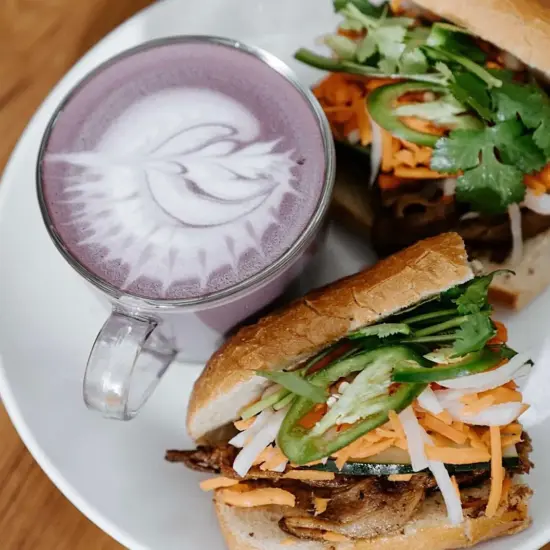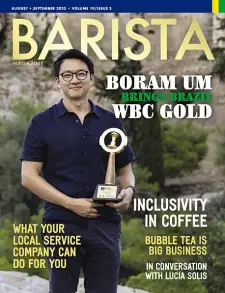
Thinking of incorporating ingredients from other cultures into your menu? Here’s how to do so mindfully.
BY EMILY JOY MENESES
BARISTA MAGAZINE ONLINE
Featured photo by Nathan Dumlao via Unsplash
I remember the first time that I saw ube being used in a non-Filipino establishment. Mixed feelings coursed through me. On one hand, I was happy to see an ingredient from my family’s culture being shared. When I was a child, Filipino cuisine was often misunderstood or underrepresented in the world around me. On the other hand, I felt cautious. Would something precious to me (an ingredient that was native to the land that both of my parents were from) be treated with the respect and care that it deserved?
Cultural exchange is a natural part of human existence, and, in many ways, it’s what makes life worth living. After all, where would I be if it weren’t for the multitude of cultures that permeate my city, Los Angeles? I love walking down the street in L.A. and coming across food and beverages from cultures around the world.
Learning about cultures outside of our own and incorporating their ingredients into our daily lives is a beautiful thing! However, it’s important to do so from a place of curiosity and respect—in a way that honors each ingredient’s roots. Are you considering incorporating ingredients from outside of your own culture into your menu? Here’s what to consider so that you can do so mindfully.
1. Know what cultures your ingredients come from and how they’re traditionally used.
When introducing a new ingredient to your menu that’s outside of your culture, first do some research on where the ingredient comes from. See how it’s traditionally used in the cultures from which it originated. For example, ube—outside of being used in coffee beverages here in the Western world—is most commonly used in Filipino desserts like ube halaya (a jam made from the purple yam) or halo halo (a shaved ice dessert). Knowing how the ingredient has been used throughout the centuries is a good way to stay connected to the ingredient’s roots. And it will better inform your own use of the ingredient!

2. Acknowledge and uplift the communities/cultures that the ingredients come from.
Another great way to respectfully approach cultural ingredients is to shine a light on the communities and cultures that your ingredients are coming from. Educate your customers on where the ingredient comes from. Do your best to source your ingredients from people of the cultures they originate from. For example, if you’re using ube, you can visit local Filipino/Asian markets or vendors and source your ube from them.

3. Avoid thinking of these ingredients as passing trends but rather as permanent and important fixtures of others’ cultures.
Lastly, the most important aspect of approaching cultural ingredients is altering your perspective of them and why you want to use them in your café. Try not to think of these ingredients as passing “trends“ or simply as a way to attract more customers. Instead, pursue these ingredients as a way to learn about and highlight other cultures, introducing your customers to different flavors from around the world. Building conversations around your ingredients and where they come from will be beneficial to all involved.
A Café Owner’s Perspective
Kim Dam, founder of Portland Cà Phê, is known for infusing her Vietnamese background into her work at her café. Her menu features single-origin Vietnamese coffee that she roasts herself in PDX, traditional cà phê sua dá (Vietnamese iced coffee), and ingredients inspired by her Southeast Asian background.
“One ingredient that’s currently on my menu for a summer special is pandan,” she shares. Kim is referring to an iced pandan coconut cream beverage that Portland Cà Phê recently added to their drink repertoire. “I grew up eating pandan—it was sort of like my version of vanilla, and it was in a lot of pastries I loved. One of my favorite (desserts) is a pandan coconut bar that you can find at Asian markets. It’s very nostalgic for me,” Kim says.

When asked how both café owners and customers can respectfully approach new flavors from other cultures, Kim points out the importance of education. “(For café owners) … being educated on the cultural background of the ingredient is helpful—and making sure you’re putting some thought into your recipe to make sure it’s working well with the drink you’re creating.”
“For customers, I just want to say: Be open to trying something new! And if (an ingredient) isn’t for you, keep it to yourself,” she suggests. “We understand that these drinks are different—but we put a lot of thought into how we want to present these drinks. You can’t knock it until you try it.”
ABOUT THE AUTHOR
Emily Joy Meneses (she/they) is a writer and musician based in Los Angeles. Her hobbies include foraging, cortados, vintage synths, and connecting with her Filipino roots through music, art, food, and beverage.

READ THE LATEST BARISTA MAGAZINE
Out now: It’s the August + September 2023 issue of Barista Magazine, featuring Boram Um of Brazil on the cover. Read it for free with our digital edition. Get your Barista Magazine delivered; start a subscription today! Visit our online store to renew your subscription or order back issues.

